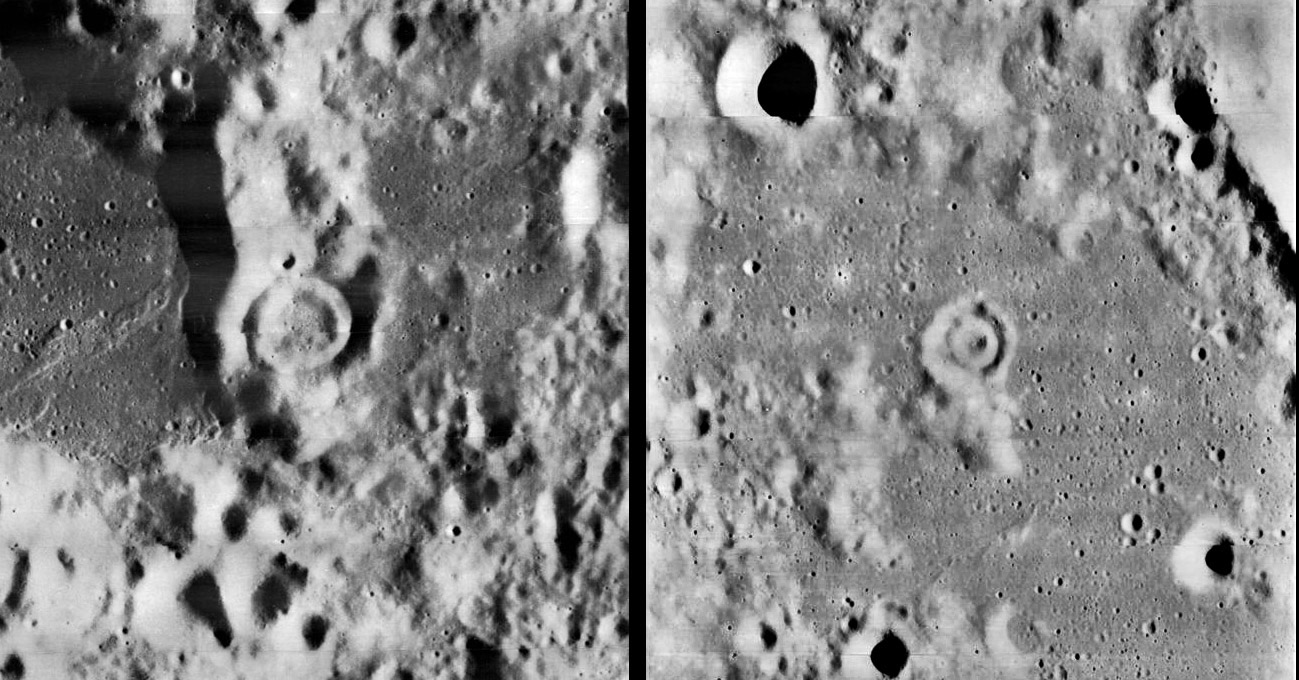October 10, 2017
Two New/Old CCs
Originally published March 30, 2008

Lunar Orbiter I-27 (right) and I-26 (left) images from LPI Lunar Orbiter Photo Gallery
Yesterday while looking at Lunar Orbiter I images near Mare Smythii I discovered two new concentric craters. Or so I thought until I checked my catalog from 1978. Oops, I had previously discovered these on Lunar Orbiter IV-178. The higher resolution views of Lunar Orbiter I do permit new observations and ruminations. The concentric crater (CC) on the left is one I cataloged as #12 Near Schubert N, and it had (in 1978) a diameter of 9.9 km. The CC on the right is #11 Near Dubiago with a diameter of 4.6 km. One theory is that CC are normal impact craters that developed an inner ring because the impact occurred on a layered surface (usually on thin mare lava), with the outer rim formed by interaction with the mare and the inner by interaction with the sub-mare layer. A second idea is that the inner ring forms by some sort of volcanic eruption. In both CC shown here the inner rings look somewhat less degraded than the main rims. This would argue that the inner and outer rims were not produced at the same time. Additionally, both CC seem to have formed before the mare so there may not have been a double layer at time of impact. Both observations support the non-impact origin. It is wonderful to get insight from 43 year old data! Think what we could do with new data...
Chuck Wood
Related Links
Rükl plate 38
Yesterday's LPOD: Eastern Strangeness
Tomorrow's LPOD: Bumps And Channels And Long Mountains
COMMENTS
(1) Readers unfamiliar with the Lunar Orbiter camera system -- and envious of the remarkable sharpness of views like these showing detail to perhaps 150 m on the lunar surface -- may be interested to know that these shots were obtained with the medium resolution camera, using an aperture of a mere 14 mm (80 mm focal length at f/5.6) -- smaller than the cheapest binoculars. The reason they show more detail than the later Lunar Orbiter IV images taken with the larger 109 mm aperture high resolution camera (610 mm focal length, also at f/5.6), is that LO-I took these from a range of 228 kilometers, whereas LO-IV (to get a wider view) was looking from around 6000 km. At that distance, even the nominally 8-times sharper sighted high resolution camera could only make out detail at the 1-1.5 km level, and the medium resolution camera shows the whole Moon and more (rather blurrily). The advantage of getting close to the target can't be overstated, and some LO photos were taken from considerably closer range than these.
The stated resolution limits of the two LO camera systems (according to Bowker and Hughes) are 34 and 4.4 arc-seconds, respectively. Surprisingly, the very nice resolution shown on these prints doesn't seem up to that standard (150 m at a distance of 228 km is 660 micro-radians or about 140 arc-seconds) -- so perhaps these photographic prints aren't showing the LO-I results to full advantage. Considering that spacecraft don't have to contend with seeing, Earth-based amateurs might find even the stated resolution rather poor for these apertures (the numbers given are about a factor of 3.5 short of such lenses' diffraction-limited potential), but spacecraft engineers have many other equally complicated issues to deal with including, in this case, a complex film system.
The present LO-I photos, taken on August 19, 1966, fall in a region later carefully studied and mapped (at high sun angle) by the more powerful Apollo Metric cameras (operating at a distance of about 100 km). As a result, the LO-I prints can be rather easily registered to the detail shown in the LTO's using software like LTVT. This permits more accurate measurement of the dimensions of these features. The CC on the left is about 10.5 km in diameter (measured at the rim-crest), and the quite concentric inner ring is 5.5 km (also measured at the rim-crest). The CC on the right is 5.7 km in diameter, with a considerably offset inner donut of 2.5 km diameter (the smaller 1978 values probably weren't completely corrected for the oblique angle of view which makes these distant features look smaller than expected). The shadows in LO-I-126M (sun angle +18.65°) verify the general accuracy of the contours shown in LTO-81A1 (the CC is centered at 73.67°E/1.33°N). LTO-62C3 is pretty ambiguous about the smaller CC (at 68.55°E/3.69°N), and the shadows in LO-I-027M (where the sun angle is +15.4°) aren't very clear either, but since at a lower sun angle they are less strong than in the larger one, the surface slopes must be gentler.
-- Jim Mosher
COMMENTS?
Register, Log in, and join in the comments.



